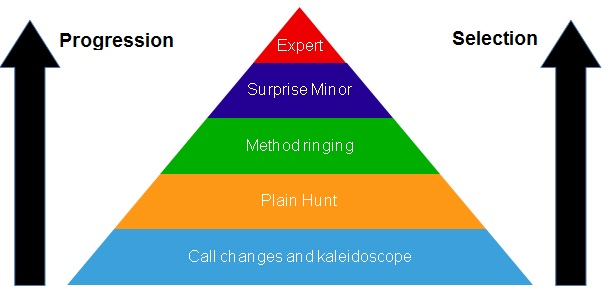Teaching Tips
4. Looking after the band
4.2. Keep ALL your ringers ringing
Every activity wants to keep the numbers of participants as high as possible and keep people involved for as long as possible. Ringing is no exception. We want to retain the ringers we recruit. The traditional model in ringing development is the Pyramidal Model.
The Pyramidal Model – high "burn out" rates
In this model there are fewer participants as progress advances. The drive is to improve performance with a wide initial base and an increasing dropout rate. Constant pressure to progress means this model is associated with a high “burn out” rate, with many participants unable to progress and leaving the activity.

The Pyramidal Model is no longer seen as an efficient way of producing high-end performers. Research has shown that early talent is not necessarily a good predictor of eventual performance, with many high performers emerging late.This can be seen in ringing when people return to ringing after many years and then make quick progress with method learning.
There has been a significant amount of research done over recent decades into different approaches to maintaining participant numbers in various activities.
The needs of the participant change as the person grows from child to teenager to adult and then on to older adult. The needs of the participant change depending on the stage of progress they are at, for instance if they are a beginner, a ringer who wants to ring for Sunday service but has no desire to learn more methods, a keen ringer who is developing skills fast or a high performer.
The Participants' Needs Model – increased number of people participating
Researchers such as Professor Istvan Balyi have developed new ideas to encourage lifelong participation and thus to increase numbers of participants. These ideas have been taken on by UK Coaching. Various groups such as The British Canoe Union and British Cycling have applied these research findings to their own activities.
The result of this research has been new ways of thinking about the development of the individual participant, the Participants’ Needs Model.

This model of development is built around the requirements of the individual at every stage of their development. More people stay involved, there are many pathways to excellence and the emphasis is placed on personal goals. The needs of those who wish to participate for mainly recreational reasons are catered for, as well as those who are ambitious to progress.
Both models lead to an equal proportion of those who perform at a high level but the Participants Needs Model leads to a greater number of people participating, via various diverse pathways.
The model develops and recognises various “recreational pathways” which keep people participating without always having to progress at certain particular points in time. Coaches are encouraged to show increased respect for the wishes of the recreational participant and to adapt their coaching style to incorporate their needs. These ringers should be coached with a view to “sustaining participation”. Goals for these ringers would be less ambitious in terms of learning new methods than for those for ringers following a “progressive pathway”. They would include improving performance at current level of advancement, i.e. what has already been learned and diversifying at a similar level, rather than concentrating on advancing to more complicated ringing.
In this manner individuals become free to enjoy their ringing without constant pressure to learn more. At certain stages in individual’s lives the pressure for constant advancement may become more than people want and can prove counterproductive, leading to “burn out” and the loss of that ringer. By providing for the needs of the ringer who has no ambition to advance their method ringing at that point we are more likely to keep them participating in the activity. It may be that later, a time may come when a ringer will become more motivated and move on to follow a progressive pathway again.
By coaching to “sustain participation” of those who have temporarily moved onto a recreational pathway, we will ensure that those ringers will remain involved and will be in a position to return to a progressive pathway at some point in the future moving forwards with their method ringing once more, rather than being lost to ringing.
Pip Penney